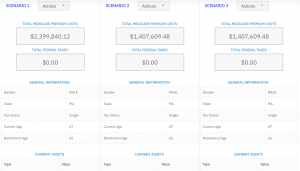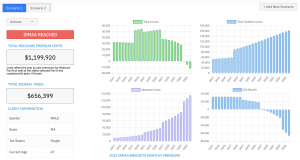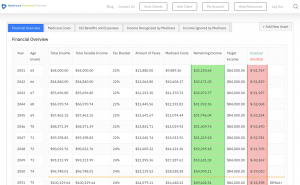It’s that period once more when we all take a long, calming breath and prepare for the upcoming Medicare Part B premium. You guessed it, 2024 has rolled around with its own set of numbers to crunch. What is Medicare part b premium for 2024? Let me tell you—it’s like looking at your grandkid’s wish list; some surprises are inevitable.
The mailbox ritual isn’t just about holiday cards anymore, but also those official letters spelling out health care costs for the coming year. This go-around, it’s $174.70 per month—yep, up from last year.
I know what you’re thinking: another jump? Yet, despite the seemingly steep cost increase, there is a hidden benefit to these premiums that can greatly impact our financial security and well-being.
Come along as I break down not only the figures but also shed light on why your income could change the game or how staying informed can save you a bundle over time…
2024 Medicare Part B Premium Overview
Brace yourselves, because the Medicare Part B premium for 2024 is doing a bit of a cha-cha. It’s stepping up to $174.70 per month—that’s an extra $9.80 shimmying out of your pocket compared to last year.
We’re not just talking chump change; this bump affects millions who rely on health care services, from doctor visits to getting their hands on life-saving prescription drugs. But what’s behind this hike? Let me tell you—it’s like peeling back the layers of an onion, and yes, there might be some tears involved.
Key Factors Impacting the Increase in Premiums
You see, health care spending is as predictable as my grandma’s mood before her morning coffee—volatile. With costs bouncing around each year due to factors like inflation reduction efforts or changes in medical equipment pricing, our monthly premiums feel the heat too.
This increase isn’t pulled out of thin air; it reflects real-world shifts in how much we spend on things like durable medical gear and those pesky coinsurance amounts that can burn holes through wallets faster than a hot knife through butter.
The standard monthly premium sets the stage but remember—the band plays different tunes depending on your income bracket thanks to something called income-related monthly adjustment amounts (IRMAA). If you’re rolling in dough—or at least if Uncle Sam thinks you are based on your modified adjusted gross income—you’ll pay more than that baseline number I mentioned earlier.
Coverage Benefits Under Medicare Part B
Digging deeper into what gets covered by that steeper price tag may soften the blow slightly. We’re looking at outpatient hospital services being taken care of along with preventive measures so you don’t fall ill every time flu season rolls around—and trust me, nobody has time for sniffles and sneezes these days.
It also puts its money where its mouth is when it comes down to nursing facilities stays—not exactly five-star resorts but essential nonetheless—and supports other extended care services which ensure Grandma doesn’t have any complaints post-surgery (besides about her jello portion size).
Key Takeaway:
Get ready for the Medicare Part B dance in 2024, with premiums jumping to $174.70 a month—$9.80 more than last year. This isn’t just loose change; it’s due to healthcare costs swinging wildly from inflation and price changes in medical gear.
The increase also depends on your income—the higher it is, the more you pay above that base premium. But what you get is worth noting: coverage includes outpatient services and preventive care to keep those flu bugs at bay, plus support for nursing facilities when needed.
Adjustments Based on Income Levels
Your Medicare Part B premium isn’t a one-size-fits-all figure. Think of it like a tax bracket—it slides up based on your modified adjusted gross income (MAGI). If you’re riding high in the earnings department, expect to pay more than the standard monthly premium for your health care services.
Determining Your IRMAA Bracket
To know if you’ll be paying extra, it’s all about your MAGI. It’s all about that magic number: your MAGI. For those with incomes higher than $91,000 as an individual or $182,000 when filing jointly in 2024 will see their premiums adjust accordingly because of what’s known as income-related monthly adjustment amounts—or IRMAA for short.
This isn’t just chump change we’re talking about; depending on where you land within these brackets, the cost difference can be significant. Let’s say Uncle Sam looks at your tax return and sees that hefty gross income—you could end up parting ways with quite a bit more cash each month for those same Medicare benefits.
To give this some real-world context without making eyes glaze over—think ordering an espresso shot versus getting hit by an entire caffeine truck. Just like there are levels to coffee potency, there are tiers to how much more greenbacks get funneled into Medicare costs due to increased earnings reported on IRS forms—and trust me; nobody likes surprises come payment time.
If terms like “IRMAA” and “modified adjusted gross” sound Greek to you now but have potential relevance down the line (like around April 15th), it might be wise to check out official guidelines. They’ll help make sure next year doesn’t start off with sticker shock from higher-than-expected healthcare bills.
The bottom line is this: Being informed pays off—literally. Knowing which side of the sliding scale you’re likely going to fall on helps you budget better today, so tomorrow doesn’t become unnecessarily stressful when faced with unexpected adjustments in medical expenses related to Part B coverage. Be equipped with the intel, and you can budget securely without any unforeseen shocks that could disrupt your financial plan.
Key Takeaway:
Medicare Part B premiums go up if you earn more, just like tax brackets. Check your MAGI to see if you’ll pay extra and avoid budget-busting surprises.
Coverage Benefits Under Medicare Part B
Think of Medicare Part B as your shield against the high cost of health care services. It’s like having a good buddy who steps in to cover many medical expenses, from doctor visits to preventive services that keep you healthy.
Preventive Services Covered by Plan
If staying one step ahead of illness is your game plan, then free or low-cost preventive services are your MVPs. Picture yourself walking into the clinic for a flu shot and not paying a dime because Medicare has got it covered. Or imagine scheduling screenings that don’t hurt your wallet—Medicare Part B makes these smart moves possible.
Beyond keeping pesky viruses at bay with vaccines, this coverage includes important cancer screenings and tests for conditions that could sneak up on you if left unchecked. By catching issues early, you’re not just saving money—you’re potentially saving something far more valuable: Your health.
Outpatient Care and Medical Supplies
No one likes surprises when it comes to their health—or their bills. That’s where outpatient hospital services come into play under Medicare Part B. Whether it’s routine doctor appointments or life-saving treatments like chemotherapy, being covered means peace of mind without those jaw-dropping costs.
You also get backup for necessary warriors in healthcare battles: durable medical equipment (DME). We’re talking wheelchairs to stay mobile; oxygen tanks so breathing doesn’t become an extreme sport; blood sugar monitors making diabetes management less daunting—all part of the lineup aiming to keep you out there living life instead of worrying about gear costs.
“Knowing what’s covered can be empowering—it turns patients into informed champions for their own well-being.”
In short, with every checkup visit or medical supply need fulfilled under Medicare Part B coverage, health care spending becomes less spooky, leaving more room in budgets—and lives—for everything else.
Key Takeaway:
Medicare Part B is your health care sidekick, covering a slew of costs from doctor visits to preventive measures and essential medical supplies. Free vaccines? Check. Cancer screenings on the house? You got it. Outpatient services without the sticker shock? Absolutely. Gear up with durable equipment like wheelchairs at no extra stress to you.
Deductibles and Coinsurance Explained
Figuring out your Part B expenses under Medicare can seem like a challenging puzzle. In 2024, the annual deductible for all beneficiaries is set at $240—think of this as your entry fee into the world of covered services. Once you’ve paid up, Medicare covers its share.
But what about after meeting that deductible? That’s where coinsurance kicks in—a term that sounds fancy but really just means splitting the bill with Medicare. For example, if we talk extended care services beyond hospital stays (because let’s face it, nobody plans a vacation there), daily coinsurance amounts will be $204.00 per day for days 21 through 100 each benefit period within skilled nursing facilities; it’s sort of like going Dutch on health care expenses.
This can add up quickly, so understanding these numbers helps keep surprises off your medical bills and lets you plan better than a surprise birthday party organizer. It’s not just about staying healthy—it’s also being smart with how much you’ll need to shell out when life throws curveballs at your wellness game.
Annual Deductible for Medicare Part B in 2024
The first thing folks usually ask me is “What do I gotta pay before my coverage starts doing its thing?” Well, picture this: You walk into an arcade and have to change cash for tokens before playing any games—that initial exchange is similar to hitting your yearly deductible mark.
In simpler terms—the less fun part—you must fork over $240 from those precious retirement funds or savings before waving goodbye to full-price payments on most doctor visits or outpatient procedures under Part B coverage during our trip around the sun called ‘yearly’. Remember though; preventive services might not cost you anything extra because keeping folks healthy upfront saves everyone more dough down the line.
Coinsurance Amounts for Medicare Part B Services
We’ve tackled deductibles; now onto sharing costs—coinsurance style. Imagine every time getting healthcare service turns into splitting lunch with Uncle Sam after he kindly pays his fair share first (thanks buddy). Now whether it’s grabbing flu shots or needing durable medical equipment so sturdy even superheroes would approve—we’re talking shared payment responsibility here post-deductible meets meet-and-greet session).
To get technical without making brains hurt: once past that initial hurdle (deductible), expect roughly an 80-20 split—with good ol’ government-run insurance covering four-fifths while leaving one fifth back on personal tabs… unless additional help applies via other programs aimed at cutting individual spendings further down.
Key Takeaway:
Medicare Part B’s 2024 deductible is your ticket to covered services—just $240. After that, it’s a cost-sharing game with coinsurance, like splitting the tab for health care. Get these numbers straight to dodge bill shock and keep your savings safe when health hiccups happen.
Comparing Past Years’ Premiums to 2024’s Rates
Talking dollars and sense, the Medicare Part B premium for 2024 is playing leapfrog with past years, landing at $174.70 a month. That’s a hop up of $9.80 from last year’s playground.
Remember when we could get away with lower premiums? Ah, those were the days. But like bell-bottoms and disco balls, low premiums are becoming relics of the past as health care spending inflates faster than a balloon on New Year’s Eve.
If you’re scratching your head wondering how this stacks against yesteryears’, buckle up because here comes some number-crunching fun: The annual deductible that all beneficiaries face will be sitting pretty at $240 in 2024; meanwhile daily coinsurance for extended care services jumps to $204 smackeroos—so if you’re planning an extended stay anywhere but home, pack your piggy bank.
Key Factors Impacting the Increase in Premiums
Digging into why these numbers keep climbing can feel like unpacking your attic—where did all this stuff come from? Well folks, it boils down to more people using more services (thanks boomers.), fancy new medical equipment that costs an arm and maybe even part of a leg, plus drugs hitting pockets harder than ever despite efforts like Inflation Reduction Act goodies.
The standard monthly premium might make us grumble every time we open our wallets, but hey—at least it isn’t determined by spinning a giant wheel of fortune (although sometimes it feels that way). It actually ties back to things like gross income which frankly seems unfair since I don’t remember agreeing to inflation eating my lunch money.
Coverage Benefits Under Medicare Part B
Luckily though while we talk about paying more dough for coverage under Plan B, let me sprinkle some silver lining onto this cloud—it still includes vital outpatient hospital services. You’ll also have access to necessary durable medical supplies without having to cross rivers or climb mountains.
Key Takeaway:
Medicare Part B’s 2024 premium is $174.70, a noticeable jump from last year. Health care costs are ballooning and so are our deductibles and coinsurance fees—budget wisely for health expenses.
The climb in premiums? Blame it on more people needing services, pricey tech updates, and costly meds—even with new laws trying to ease the sting.
Plan B might hit your wallet harder this year but remember—it’s got you covered for crucial outpatient services without an epic quest for equipment.
Prescription Drug Coverage Linked to Plan B Premiums
When you think Medicare Part B, don’t forget about prescription drugs. Sure, your monthly premium for that gym membership keeps you fit, but the Medicare Part B premium is what helps keep those medical bills in check. In 2024, we’re looking at $174.70 each month—a modest hike from last year’s rate.
The standard immunosuppressive drug premium has been pegged at $103.00. That’s like paying for a top-tier streaming service just so you can get the meds needed after an organ transplant—vital yet pricey. But let’s not gloss over how these premiums affect overall health care costs.
How Medicare Part B Premium Affects Prescription Drug Coverage
Buckle up because here’s where it gets twisty: opting into Medicare Part D drug coverage might give your wallet a workout too. It’s tied to Plan B; more specifically, if your gross income got some serious gains and went heavyweight on us (we’re talking modified adjusted gross level), expect to shell out extra dough through income-related monthly adjustment amounts—or IRMAA as insiders call them.
You’ll want to be sharp with numbers here since they determine whether or not that extra slice of pie called IRMAA will be served alongside your standard monthly premium plate.
Digging Into The Details Of Plan D Costs With PlanB Ties
Mixing up Plans? Here’s a quick fix: Think of Medicare Part D as the side dish to your main course of outpatient hospital services and doctor visits covered by Medicare Part B coverage. Now add on plan d drug coverage which steps in like dessert when it comes time for prescriptions—and voila.
We’ve all seen our share of “plot twists” when budgeting healthcare spending—but who said there couldn’t be good surprises? For example, while some folks may pay premiums straight-up without flinching others might find their social security benefits have taken one look at those rising prices and said ‘Nope’. So make sure you know where stand before ringing up that pharmacy tab.
Key Takeaway:
Think of Medicare Part B’s $174.70 monthly premium as your health’s gym membership, keeping medical costs in check. Don’t forget the Plan D tie-in: if you’re earning big, brace for an extra hit from IRMAA on top of that.
Your Social Security might just say ‘Nope’ to covering rising premiums, so know your numbers before hitting the pharmacy.
Additional Health Services Affected by PlanB Premiums
If you think Medicare Part B premiums only affect your doctor visits, it’s time to peek behind the curtain. Just like a stage crew works magic backstage, Plan B plays a pivotal role in other health services too. For starters, extended care service charges don’t dodge the premium bullet.
We’re not just talking pennies here; if you need skilled nursing facility care after a hospital stay, for instance, those costs can add up faster than popcorn kernels popping at movie night. And let’s be real—nobody wants their savings gobbled up because they needed some extra help recovering from surgery or illness.
Extended Care Service Charges and Skilled Nursing Facility Care
The ripple effect of rising Plan B premiums stretches into areas like home health care service fees. That means when someone needs medical attention at home—a setup many prefer—the cost could hinge on what happens with these premiums.
Budgeting for health is already as tough as trying to solve an escape room puzzle blindfolded. But get this: the standard monthly premium hike isn’t going rogue; there’s method to its madness. The increase supports improvements in these very services that keep us ticking along when we’re under the weather or managing chronic conditions.
Home Health Care Service Costs Under Scrutiny
A glance at our bank statements might make us feel nostalgic for lower Medicare Part B coverage rates but remember that quality comes with a price tag—and sometimes that price reflects new breakthroughs in patient care or technology advancements (you wouldn’t use your grandma’s flip phone over today’s smartphones now would you?). So while higher costs may pinch initially—they’re often pushing healthcare forward in leaps and bounds.
To cap it off: consider how much more peace of mind having access to top-notch skilled nursing facilities brings—not something easily quantified but priceless nonetheless. Don’t forget—you can always check out the latest updates on 2024 Medicare Parts A and B premiums and deductibles right here, so no nasty surprises sneak up on you next year.
Key Takeaway:
Think Medicare Part B premiums only hit doctor visits? Think again. They also impact your extended care and home health service costs—key stuff when you’re on the mend. But remember, while no one likes shelling out more cash, these hikes help improve crucial services and can offer peace of mind that’s worth every penny.
Broader Implications of Changes In PlanB Costs
Think about it—when Medicare Part B premiums go up, they don’t just poke your wallet; they can also mess with eligibility for Medicaid services and Social Security benefits. It’s like a game of dominos where one tile tips over a bunch more.
If you’re buying into Part A at a reduced rate, which is now $278 per month, or facing the inpatient hospital deductible set at $1,632—it adds up faster than calories on Thanksgiving. No one enjoys unexpected medical expenses.
Buckle up because higher Plan B costs might mean some folks could get nudged right out of qualifying for certain Medicaid services. Imagine finally getting that golden ticket to the chocolate factory only to find out there’s an income check at the door—that’s what we’re talking about here.
Dollars and Sense: The Ripple Effect on Health Care Spending
You’ve got these lifetime reserve days tucked away like emergency money under your mattress—they come in handy if you need extended hospital stays without paying full price forever. But did you know each day burns through $778? Yep, those precious reserve days are tied directly to your standard premium changes too.
Social Security benefits aren’t immune either; they take their cues from this financial tango as well. So while grandma gets excited about her cost-of-living adjustment (COLA), she might not notice how rising Medicare premiums eat into that extra cash quicker than grandkids devouring cookies.
The Balancing Act Between Services and Savings
Now consider skilled nursing facilities—a haven after surgery or illness where healing happens around-the-clock—but guess what? Their charges align with these updates too. As do home health care service fees—which means both personal savings and wider healthcare systems feel this pinch.
This isn’t just scaremongering; it’s economics 101 colliding head-on with our everyday lives because things like drug coverage under Plan D will also dance to the tune of Plan B’s new beat—the two are intertwined tighter than earbuds left loose in a pocket.
Key Takeaway:
Medicare Part B premium hikes can knock on the door of Medicaid eligibility and Social Security benefits. Remember, from hospital stays to skilled nursing fees, these changes hit personal budgets hard—like surprise healthcare costs at the worst time.
The domino effect of Medicare adjustments doesn’t skip a beat—it shakes up everything from your emergency reserve days to your drug coverage under Plan D. It’s not just about monthly premiums; it’s a full-blown budget ballet where every step counts.
FAQs in Relation to What is Medicare Part B Premium for 2024
Is Medicare Part B free at age 65?
No, you’ll still have to pay for Medicare Part B even after hitting 65; it’s not a freebie.
What are the changes in Medicare in 2024?
New year, new rates. Expect tweaks to premiums, deductibles and coverage details come 2024.
What is the income limit for Part B?
Your premium jumps if your income tops $91k solo or $182k filing jointly. Keep tabs on that cash flow.
How much will Medicare Part B premiums be in 2024?
Buckle up: You’re looking at shelling out $174.70 each month for those over-65 health needs.
Conclusion
So, you’ve navigated the Medicare maze and landed here. Remember, what is Medicare Part B premium for 2024? It’s $174.70 per month—yes, an uptick but not without reason.
Take this away: Your income matters. Higher earners will see a shift in their monthly adjustment amounts; keep that gross income in check to manage costs.
And don’t forget coverage perks! From flu shots to doctor visits, know your benefits inside out—it could save you more than pennies.
Last up: Trends are telling. The climb from past years’ premiums gives us insight into future health care spending—stay informed to stay ahead.
In all this, remember practicality reigns supreme when managing your healthcare expenses with savvy and foresight!
Table of Contents:
- 2024 Medicare Part B Premium Overview
- Adjustments Based on Income Levels
- Coverage Benefits Under Medicare Part B
- Deductibles and Coinsurance Explained
- Comparing Past Years’ Premiums to 2024’s Rates
- Prescription Drug Coverage Linked to Plan B Premiums
- Additional Health Services Affected by PlanB Premiums
- Broader Implications of Changes In PlanB Costs
- FAQs in Relation to What is Medicare Part B Premium for 2024
- Conclusion
Streamlining the Medicare Surcharge Calculation Process.
Our Healthcare Retirement Planner software is designed to streamline the retirement planning process for financial professionals. By providing an efficient way to calculate IRMAA costs, our tool helps you save time and focus on other aspects of your clients’ retirement plans.
- Faster calculations: Our software quickly calculates IRMAA costs based on your client’s income and tax filing status, eliminating manual calculations and potential errors.
- User-friendly interface: The intuitive design of our platform makes it easy for financial professionals to input data and generate results with minimal effort.
- Data integration: Seamlessly integrate our calculator into your existing financial planning tools or CRM systems for a more streamlined workflow.
- Easy to Understand Reports: Export reports to easily share with your clients
- Tax and Surcharge Modeling: see how different types of income affects both taxes and your surcharges.
In addition to simplifying the calculation process, using our Healthcare Retirement Planner can also help improve communication between you and your clients. With clear visuals that illustrate how IRMAA costs impact their overall retirement plan, you can effectively convey complex information in an easily digestible format. This enables clients to make informed decisions about their healthcare expenses during retirement while ensuring they are prepared for any potential changes in Medicare premiums due to income fluctuations. To learn more about how our software can benefit both you as a financial professional and your clients’ retirement planning experience, visit the features page. Streamlining retirement planning processes can help financial professionals save time and resources, allowing them to focus on other areas of their clients’ needs. Automated calculation of IRMAA costs is the next step in streamlining this process even further.





